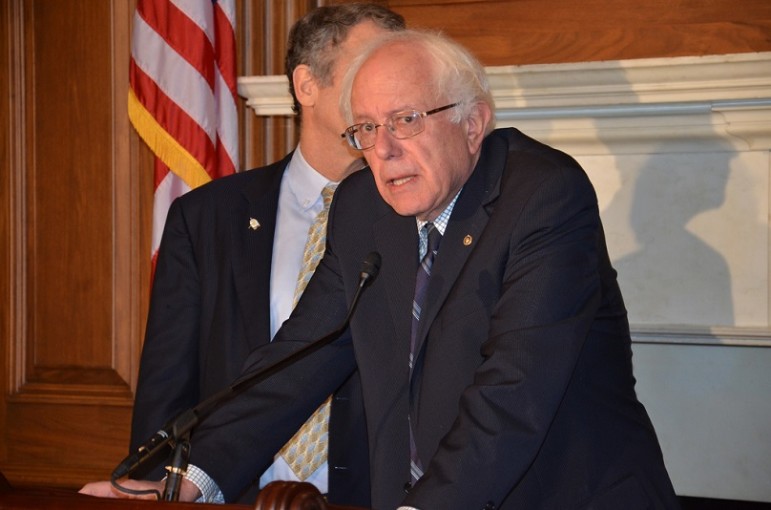
April 17, 2016; Observer
After months of waiting for the presidential aspirants to address the housing affordability crisis, Bernie Sanders has stepped forward with some sweeping proposals. The article, “Bernie Sanders Promises Massive Federal Investment in Public Housing,” in New York’s Observer newspaper hits the highlights of the Sanders initiative, which comes on the eve of the New York State primary. Like most newspaper accounts of housing policy, the story is headline rich but on a detail diet. That’s okay; after all, it is only the first rough draft of history.
The initial political impact seems like Bernie hit the mark for rent-weary New Yorkers asking for attention to housing issues. With impeccable timing, the Sanders housing agenda comes on the heels of yesterday’s CNN story lamenting the “sounds of silence” on housing issues from all the candidates. Just having a housing strategy gives Sanders some “street cred” as the campaign moves into rent-stressed Pennsylvania on its way to the West Coast epicenter of the affordability crisis in Oregon (May 17th), Washington (May 24th), and California (June 7th).
Sign up for our free newsletters
Subscribe to NPQ's newsletters to have our top stories delivered directly to your inbox.
By signing up, you agree to our privacy policy and terms of use, and to receive messages from NPQ and our partners.
Alas, there’s not much in the details to cheer communities wrestling with homelessness and housing emergencies. Secretary Clinton issued a “Housing Investment Program” back in February, but the plan has received little mention “on the trail” and in the media. And Sanders’ “Fighting for Affordable Housing” seems remarkably incremental and, dare we say it, Clintonian:
- Expand the National Affordable Housing Trust Fund. Check.
- Raise the minimum wage. The campaign needs to work harder to connect the dots between minimum wage and rent burden.
- Reinvigorate federal housing production programs. “We must return to pre-2010 funding levels by ending sequestration and invest more, not less, in affordable housing.” This is the theme of a new Center for Budget and Policy Priority study.
- Defend Fair Housing. No new programs or new funding levels mentioned. No mention of the Obama initiatives around Affirmatively Further Fair Housing, administrative protections for LGBT households, or the new pseudo-initiative around returning citizens. These could be issues where candidate Clinton can distinguish herself from Sanders and keep hip to hip with mentor Obama.
- Demand more from Affordable Housing Developers. “In my view, once we subsidize rental housing, we shouldn’t have to pay again and again simply to ‘preserve’ it.” This is actually a departure from the current models for preserving affordability and, if pursued, would be a radical re-engineering of current housing development models.
- Repair Public Housing. “We need sufficient funding for public housing operating and capital costs, and we need to reduce the unacceptable backlog of public housing capital needs.” This element of the Sanders program is a sharp turn away from current HUD policy, which favors re-capitalizing public housing stock with public-private partnerships through the Rental Assistance Demonstration (RAD) program.
- Protect Rental Assistance. Really just a reiteration of point #2.
- Expand Housing Choice Initiative. Instead of embracing a sweeping change by making housing subsidies an entitlement, Sanders offers only incremental change.
- Make HUD-assisted housing lead-free. Far from being a pledge to make federally-assisted HUD housing “lead-free,” Sanders appears to be arguing to lower the threshold of what is “lead safe.” From the statement: “Not only has HUD failed to adopt the new CDC threshold for purposes of requiring landlords to mitigate lead in apartments with children, but HUD has not updated its blood lead level standard since 1999.” Helpful tinkering, but still depends on poisoned children to be the canaries in the coalmine.
The non-rental pledges in the Sanders statement also seem to focus on “more of the same” rather than sweeping changes to current homeless and homeownership programs. No mention, for example, of changing the mortgage finance system by reforming Fannie Mae and Freddie Mac. Likewise, there’s no mention of homelessness prevention strategies despite the recent announcement that New York City was revamping its strategy. It’s okay, though. If journalism is the rough draft of history; campaign platforms are the opening shots at a real policy.—Spencer Wells













